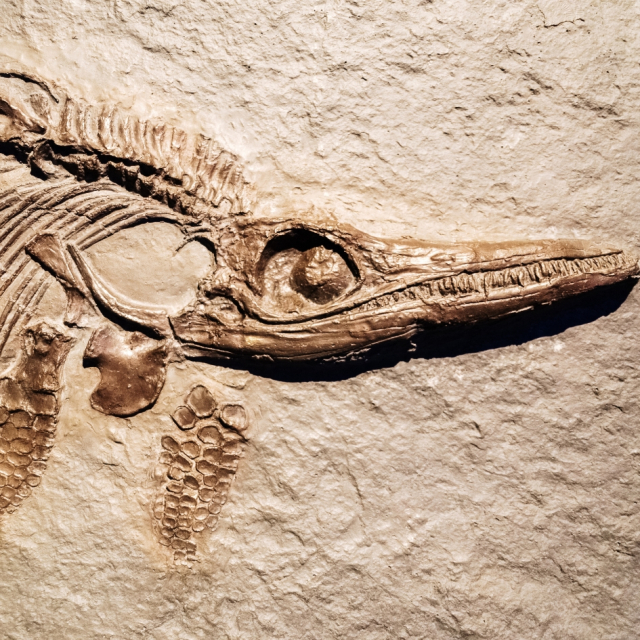Fossils are windows to the past, material traces of organisms that lived millions of years ago. These relics from ancient times allow scientists to reconstruct the history of life on Earth, study climate changes, and understand how species evolved. In this article, we will explore what fossils are, how they are formed, what types exist, and their importance in science and society.
What are fossils?
Fossils are remains or impressions of organisms that lived in past times, preserved in sedimentary rocks. They can include bones, teeth, shells, leaves, footprints, or even chemical traces that indicate the activity of organisms. According to the National Geographic portal, fossils are direct evidence of past life and offer a tangible connection to times that preceded humanity.
Fossils are found everywhere in the world, from deserts to deep oceans, and span a time range dating back more than 3.5 billion years, when the first single-celled organisms emerged.
How are fossils formed?
Fossil formation, known as fossilization, is a long and rare process that requires specific conditions to preserve biological remains. The main stages of this process include:
Quick burial:
Organisms must be quickly covered by sediments such as mud, sand or volcanic ash to protect them from decay or predators.Mineralization:
Over time, hard tissues such as bones or shells are replaced by minerals that infiltrate the pores of the organism, forming a petrified copy.Compaction and cementation:
The sediments covering the fossil are compressed and hardened, becoming sedimentary rock that encloses the remains of the organism.Exhibition and discovery:
Tectonic movements or erosion can bring fossils to the surface, where paleontologists find them.
Types of fossils.
There are several types of fossils, each providing unique information about organisms and their environments:
Body fossils:
These include physical parts of organisms, such as bones, teeth, shells, or tissues. Examples include dinosaur bones or mollusk shells.Ichnofossils:
They are traces of biological activity, such as footprints, burrows or drag marks. These fossils are valuable for understanding the behavior of organisms.Chemical fossils:
These are organic compounds that indicate the presence of past life, such as hydrocarbons or pigments.Amber:
It is the fossilized resin of trees that may contain trapped insects, plants or other organisms.Impressions and molds:
They occur when an organism leaves a mark in soft sediments, which then harden.
The importance of fossils.
Fossils are not only fascinating for their historical value, but they also play a crucial role in several areas of science and society:
Study of evolution:
Fossils are essential to understanding how species have changed over time. For example, fossil records show how dinosaurs evolved into modern birds.Reconstruction of ancient ecosystems:
Fossils help scientists recreate what past environments were like, including climate, vegetation, and relationships between species.Geological dating:
Fossils, especially guide fossils, allow geologists to determine the relative age of the rock layers in which they are found.Cultural and educational connection:
Fossils inspire curiosity and offer educational opportunities to understand the history of Earth and life.
Famous fossil discoveries.
Some fossils have changed the way we understand the history of life:
Archaeopteryx:
This 150-million-year-old fossil, discovered in Germany, shows a transition between dinosaurs and birds, with feathers and reptilian features.Lucy (Australopithecus afarensis):
Discovered in Ethiopia in 1974, Lucy is a 3.2 million-year-old hominid that provided crucial evidence about human evolution.Burgess Shale Fossils:
These Cambrian fossils, found in Canada, include an incredible diversity of marine organisms that lived more than 500 million years ago.Sue the Tyrannosaurus Rex:
This is one of the most complete T. rex skeletons ever found, on display at the Field Museum in Chicago.
According to BBC Earth , these discoveries not only expand our knowledge, but also spark a deep public interest in paleontology.
Fossils and climate change.
Fossils are also key tools for studying how the climate has changed over time and how it has influenced life on Earth. Fossil records show periods of mass extinction, such as at the end of the Cretaceous period, when an asteroid hit the Earth, causing the disappearance of non-avian dinosaurs.
In addition, plant and pollen fossils allow us to reconstruct past climate patterns, helping scientists understand the current impacts of climate change.
Challenges and controversies in the study of fossils.
Despite their importance, the study of fossils faces challenges:
Lack of complete registration:
Only a fraction of organisms fossilize, leaving gaps in the fossil record.Access and preservation:
Some fossils are found in remote areas or in danger due to human activity, such as mining.Controversies over interpretation:
Some interpretations of fossils have sparked debate in the scientific community, such as the connection between certain dinosaurs and birds.
An article in Science Daily highlights that new technologies, such as fossil DNA analysis, are helping to resolve these controversies.
Fossils are more than just inanimate remains; they are fragments of the past that tell the story of life on Earth. From the earliest microbes to giant dinosaurs, each fossil offers clues about how organisms evolved and how they responded to changes in their environment.
Studying fossils not only helps us understand the past, but also provides us with tools to address current challenges, such as climate change and species conservation. In a rapidly changing world, fossils remind us of the resilience of life and the importance of protecting biodiversity for future generations.
